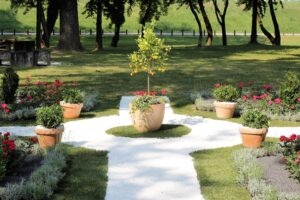A Healthy Garden Without Chemicals
There are many industrial agricultural operations which use GMOs, pesticides, herbicides, and all manner of synthetic management solutions to produce good harvests. The fallout of this is health conditions and environmental impact.
You don’t want to bring these negative consequences to your backyard garden. The following are six ways to be more green.
1. Make A Garden Big Enough To Produce Harvests You Use
Firstly, you don’t have to have a garden that produces fruits or vegetables you can actually eat—but if you do this, it’s going to make things greener. You’ll save money on groceries, save time in transit, and actually have something to show for your work.
This may take a few years, but if you do things right, you can even export your produce at profit in a greenway at local farmer’s markets throughout town.
2. Facilitate A Microclimate By Planting A Tree
Trees will produce shade and ultimately make things cooler around them. A garden near a tree can flourish even in a hot environment. However, different plants will need different levels of light. Still, if you’re not using your garden for produce, but for aesthetic effect, you can get a “secret garden” effect—there’s true elegance in proper landscaping with trees.
Eating right and exercisinghelps people flourish, proper water and sunlight helps plants flourish; some will have different needs than others. Trees make a microclimate, and that microclimate can help you serve your plants better. Plus, it’s nice to have a cool place where you can stick a bench and read without being burned to a crisp by the sun.
3. Get Free Natural Water With A Rain Barrel
A rain barrel can be used for irrigation purposes. Especially in more temperate climates where rain happens with regularity, it’s wise to use rain barrels both to save money on water, and to give yourself a secondary option should traditional grid utilities fail you for whatever reason. That you can irrigate with such solutions is just another bonus of this tactic.
4. Manage Garbage With Compost Heaps
Compost heaps can give you a means of managing your organic waste in a way that puts it to use such that plants grow better than ever. On the one hand, you decrease the “footprint” you and your family leave on the world. On the other, you’re able to grow your garden better at reduced expense.
5. Only Use Non-GMO Seeds
Monsanto is known as a monster in this area, and for good reason. Many of the plants they produce have seeds that are invasive, and end up spreading beyond the plots of land Monsanto traditionally own. Avoid GMO seeds as best you can. Beyond the fact that GMO effects on humans aren’t known yet, the plants they produce are invasive and strange.
6. Cut The Lawn Out
Your lawn requires a lot of water to keep green, and that’s expensive. Additionally, it may act as an unnecessary depletion, and it’s a lot of work to cut it every few weeks before the grass goes to seed.
You might just tear it up, put down wood chips and a stone path, then plant trees around instead. Find a solution that works for you. Reducing lawn size could help too, and allow you to more totally and successfully irrigate your garden.
https://pixabay.com/photos/bridge-japanese-garden-arch-park-53769/
A Garden That’s Truly Green
Prior the twentieth and twenty-first centuries, farmers were able to grow high-yield crops without tactics that impacted the environment as negatively as what happens today. You can even get rid of garden weed problems without using toxic herbicides.
So consider cutting out your lawn, avoiding GMOs, using compost heaps, sourcing water naturally, planting trees, and making a big enough garden that you can actually feed yourself and your family from it. These tactics will help you be greener in all your horticultural pursuits.

